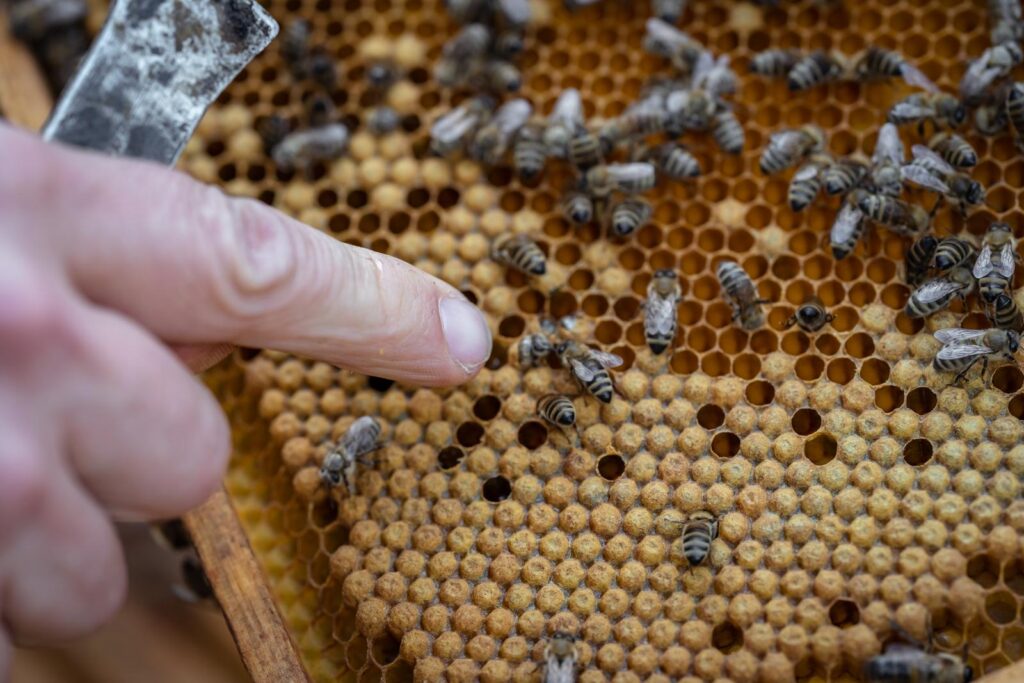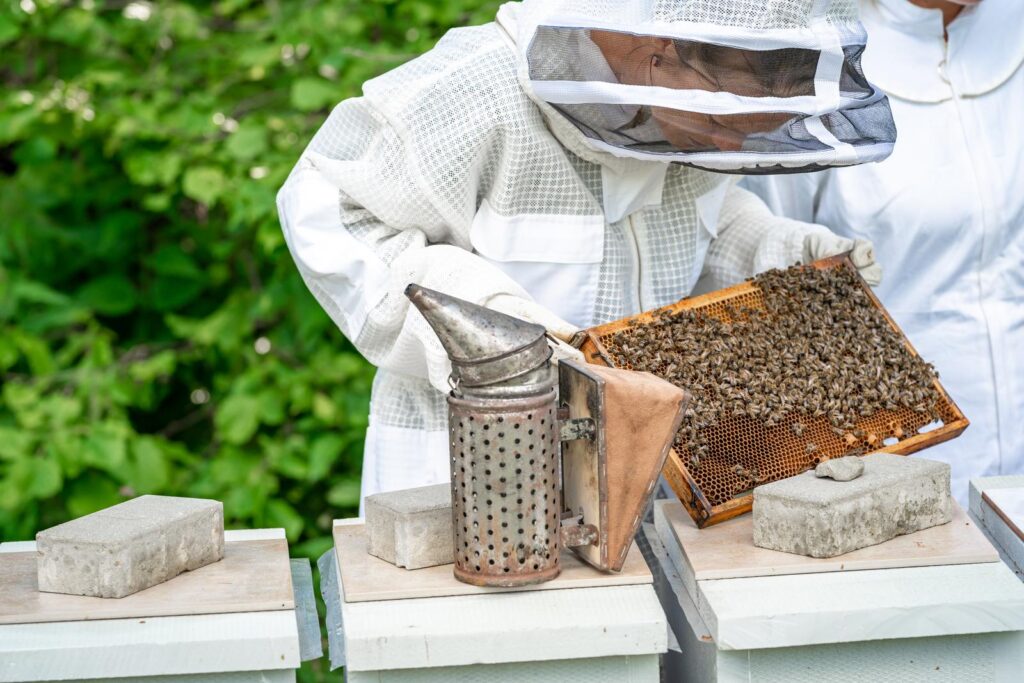So, you want to start beekeeping?
Maybe it is because you’ve decided to try to give a hive a home to help save the bees, but you don’t know where to find the bees you’re trying to save. Maybe you are a hobbyist looking to get started with a couple of hives, but now you’re stuck trying to figure out what you will need.
Or, maybe you’re looking for an exciting new career as a bee entrepreneur, but you have no clue how to set up your bee business. Everyone decides to start for different reasons, but most all beginners have the same question: “Where do I even begin?”
Well, this article is the one for you!
Follow along on this beekeeping beginners guide as we talk about some of the most important things you will need to know as you start your bee-bearing journey. We will discuss which questions you should be trying to answer during your research and planning phase, the ideal location for your first hives, how to set up a beginner’s budget when purchasing your bees, beekeeping supplies and tools, and how to manage your time best when setting up your first colony.
Take note of the helpful tips we have included along the way!
1) Research, Research, Research!
There are a lot of technical components to beekeeping. Be sure to do your FULL research before you begin to ensure that you have every chance of success with your beekeeping business. A big part of doing effective, thorough research is knowing which questions to ask.
Some Examples of Important Research Questions Include:
“What kind of beekeeping do I want to do?”
“What kind of bees am I going to keep?”
“What kind of environment do these bees need in order to thrive?”
“Do I need a permit to keep the bees in the area (example: space/yard/roof) where I intend to house them?”
“Where do I get my colony of bees and hive to keep them?”
“What hive tool will I need?”
“Where will I get my bees?”
“What time of the year is best to set up my hive and start beekeeping?”
Helpful Tip: Establishing an Effective Research Strategy
Make a checklist of questions and try to answer these questions (through research) when you’re still in the planning stages. This will give you a clearer picture of what to expect as a newbie and will keep you on track while you are establishing your first hives.
It is important to note that beekeeping has the potential to be dangerous if you don’t know what you’re doing or more concerningly, are allergic! Make sure that your research is accurate, extensive and you are getting all information from reliable sources.
Reliable sources include:
Beekeeping books
Beekeeping websites e.g. British Beekeeping Association or American Beekeeping Foundation
Established beekeepers
Online forums
Beekeeping blogs
Beekeeping mentors
You can also attend a beekeeping course, class or information day that help you out by teaching you about the more technical aspects of beekeeping theory.
Topics that may be covered in courses like these will explain how to properly choose and set up your first hive; they may help identify what kind of equipment (e.g honey extractor, honey supers) you might require; educate and instruct you on the methods of honey harvesting; teach you about your bee’s habitat; train you in hive management or explain the process of queen rearing.
Be Specific!
Remember to be specific when doing your research! The answers to your questions will all vary depending on your nationality, environment, or type of bee you have decided to keep. You may start by watching a YouTube video, but the content of the video might be better suited to beekeeping in the US, for example, whereas you might be living in India.
Bees all behave differently, eat differently, and have different temperaments. Some types of bees are more aggressive and easily provoked than others, whereas others have naturally more easy-going natures.
Basic education and sufficient preparation are key to having a better, more enjoyable, and ultimately successful beekeeping experience.
2) Location, Location, Location!
We have already discussed how important it is to do specific research as different bees will thrive best in different habitats. Now let us discuss some general rules when deciding where to place your bees.
In the beekeeping world, the area where bees are housed is called an “apiary”. This needs to be an area suitable to sustain the bees in carrying out their work through a whole season. The apiary should be reachable, protected, and safe from bad weather like rain and frost. The ideal location would be an east or southeast facing, level, sunny, dry area not more than 5 kilometres from food and water for the bees with ample drainage and good airflow.
An important consideration regarding food security for your bees is whether your chosen area for bee colonies will be able to sustain your bees throughout the whole season. The area may appear to have enough flowers, trees, or plants to sustain your colony. Be wary that this may not be the case!
It may be necessary to move your bees to more suitable areas with flowering crops. This brings about an opportunity for a win-win scenario wherein you could sell your valuable pollination services to farmers, which will aid their crop yields, while also sourcing food for your bees (with the bonus of honey)! Of course, be sure to get permission before placing your bees on anyone’s land.
Helpful Tip: Where to Set up the Apiary
If you stay in a suburb and plan to keep your bees in your yard or close to other houses, make sure that they are placed at least 50 meters from animals and people. Make sure to have your neighbour’s consent before introducing your bees to the area.
Alternatively, in rural areas such as on farms or plots of land which may house farm animals, be wary that bees do not like the smell of chickens or horses and should try to be kept as far away from these animals as possible.
3) Decide on your budget and stick to it!
Now that you’ve completed your research and know what bees you are going to keep and where you are going to keep them, it’s time to start taking steps to set up your honey bee colony. The smartest way to decide this is by drawing up a budget and sticking to it!
You can begin this budget by listing down everything you will need to purchase to get started.
If you’re not sure what you will need, this article provides a helpful guideline of everything you will need to purchase to start beekeeping, as well as an in-depth breakdown of the costs of everything you will need as a first-time beekeeper. In short, for an estimated total of $760 (according to the linked article), you will be able to afford to choose a hive type and acquire it, order your bees, purchase beekeeping tools, protective gear and other basic tools and supplies.
Costs will vary, however, depending on the choices you make and where you order from. Take note that shipping from overseas can be more expensive! Try to buy local if possible.
Once you have established your budget, stick to it! That is just good business.
Helpful Tip: When to order your supplies
Although the beekeeping season starts in spring, you should allow ample time for the initial learning curve as well as delivery times if you are ordering your equipment online. According to “Beekeeping for Newbies”, it is advisable that you order your equipment in the fall before the spring when your bees arrive.
This will ensure that things are set up and running smoothly for the bees well in advance of the season while allowing time for the equipment to arrive. Ordering in advance makes sure you are not caught off guard by delayed deliveries if you do choose to order online.
Helpful Tip: Choosing the right Hive and Bee Type for Beginners
We advise that beginner beekeepers start with a Langstroth hive. Not only is it the easiest to find suppliers for, but it is also the easiest hive to find advice about which is ideal for those just beginning.
Once you have ordered your hive, it is time to order your bees. Give yourself enough time to plan and set up for your bees but order your bees as early as possible as providers usually only have limited supplies. More so, try to order from your local beekeeper if possible! This will help alleviate some of the confusion for beginners regarding which bees to choose and help your bees as they are already acclimated to your climate.
Conclusion
Bee-bearing can be(e) overwhelming when you’re a newbie. But do not fret, this how-to guide to bee-bearing for beginners is here to clear up some of that confusion! Asking the right research questions is an important first step to ensuring that you are doing the most effective planning possible.
Many beginners only last about a year before they give up because they don’t know what they’re doing or don’t have realistic expectations going in. Having the right information, a clear plan, budget, and schedule in mind mean that you won’t be caught off guard, even when you’re thrown curveballs.
We hope that our helpful tips in this beekeeping beginners guide have provided some clarity and guidance on how to be successful as a beginner beekeeper.
Asking the right research questions is an important first step to ensuring that you are doing the most effective planning possible.
Many beginners only last about a year before they give up because they don’t know what they’re doing or don’t have realistic expectations going in. Having the right information, a clear plan, budget, and schedule in mind mean that you won’t be caught off guard, even when you’re thrown curveballs.
We hope that our helpful tips have provided some clarity and guidance on how to be successful as a beginner beekeeper.


